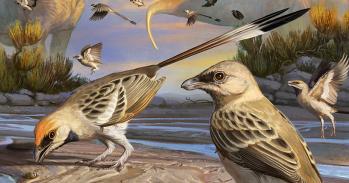
Asian vultures are at risk of lethal kidney failure if they feed from carcasses of a cow that died after treatment with the anti-inflammatory drug diclofenac.
Asian vultures are at risk of lethal kidney failure if they feed from carcasses of a cow that died after treatment with the anti-inflammatory drug diclofenac.
Asian vultures are at risk of lethal kidney failure if they feed from carcasses of a cow that died after treatment with the anti-inflammatory drug diclofenac.
Populations of three species of South Asian vulture, the white-backed vulture (Gyps bengalensis), the long-billed vulture (Gyps indicus) and the slender-billed vulture (Gyps tenuirostris), have declined rapidly within the last decade and all are now critically endangered.
Diclofenac causes fatal kidney failure in vultures and residues of the drug have been found in most carcasses of wild vultures tested since the population decline began. "Diclofenac poisoning is the main, and possibly the only, cause of the vulture decline," said Dr Rhys Green of the Department of Zoology, University of Cambridge, and the Royal Society for the Protection of Birds.
Writing in the new issue of the Journal of Applied Ecology, Dr Green says: "Our study demonstrates that diclofenac concentrations in the tissues of treated cattle decline rapidly with time after the last injection. However, enough diclofenac remains to cause appreciable mortality (more than 10%) if birds were to take a large meal from the carcass of an animal that was given its last dose of the drug within a few days of death."
Dr Green and colleagues from the RSPB, University of Aberdeen, Bombay Natural History Society and the Zoological Society of London reported concentrations of diclofenac in tissues of treated Indian and European cattle. They found that the concentration of the drug is lower in muscle than in fat or internal organs, but declines more slowly in muscle with time since treatment (the half life of diclofenac in fat, intestine, liver and kidney is six to eight hours, compared with 15 hours in muscle).
This is the first detailed study of the exposure of vultures to diclofenac and the risk of death posed by each exposure. By improving the accuracy of the model of the relationship between diclofenac in cattle carcasses and vulture mortality, this new data will help conservationists trying to save the vultures from extinction.
According to Green: "This new information will help us to assess the danger to remaining vulture populations in Asia by using residues of diclofenac measured in field surveys of cattle and buffalo carcasses. Better means of interpreting such surveys will be essential for monitoring the effectiveness of future action taken to remove diclofenac from the food supply of vultures, such as recent government measures to restrict veterinary use of diclofenac and encourage its replacement by meloxicam."
The governments of India and Nepal have both recently placed legal restrictions on veterinary diclofenac. From 12 August 2006, the production and importation of veterinary diclofenac is no longer permitted in India, and Nepal has also recently deregistered diclofenac, preventing the manufacture or import of the drug. Both countries are promoting the use of meloxicam as a safe alternative to diclofenac.
This work is licensed under a Creative Commons Licence. If you use this content on your site please link back to this page.





